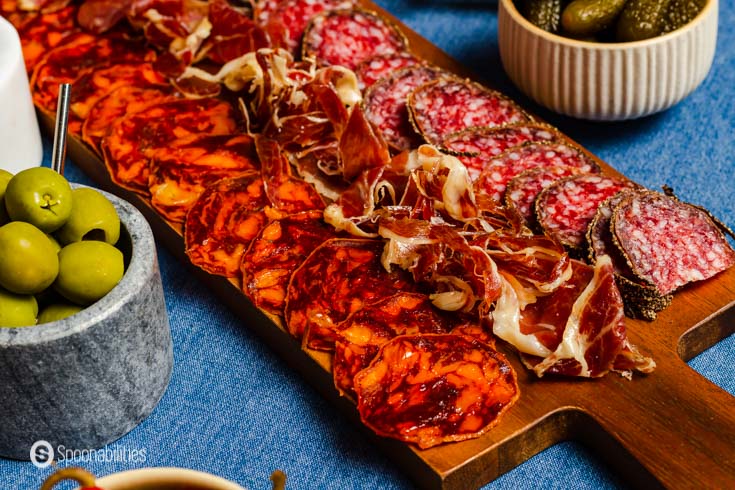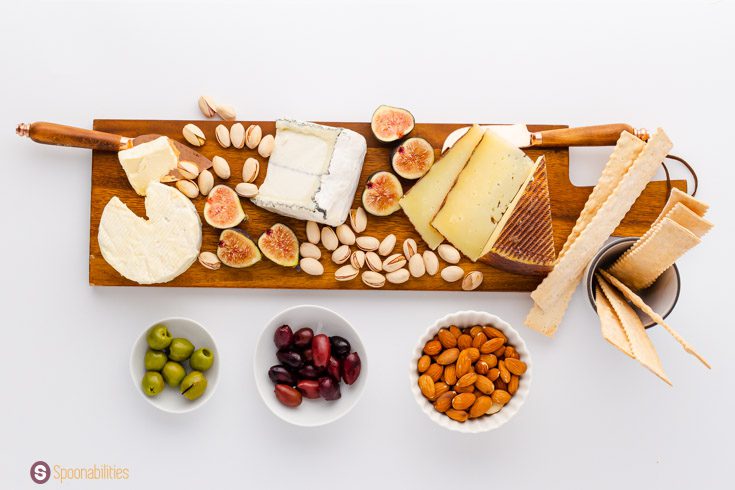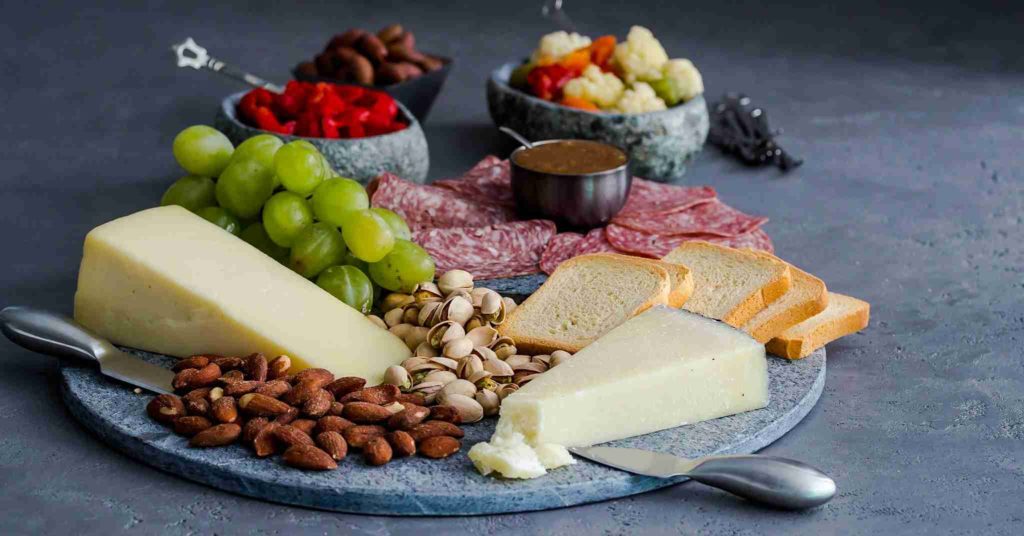Sometimes it's difficult to know where to start when deciding on meats for charcuterie boards, as well as the right types of cheese to accompany the meat selection. In this article, we'll explore some ideas with you.

What is Charcuterie?
Charcuterie is a French delicacy that is a staple of the culinary arts. It refers to a variety of meats and cheeses typically preserved by smoking, drying, or curing with salt.
Where Did Charcuterie Originate?
While the origins of this fantastic appetizer style are not entirely known, it is understood that it was popularized in France during medieval times. The French were very skilled at preserving meats without cooking them and aging various kinds of cheese, and they would often present these foods to guests when entertaining.
Why Use Meats for Charcuterie Boards?
Charcuterie boards make excellent additions to any food spread at a party, including cocktail parties and dinner parties. They allow you to serve a wide variety of tastes and textures, making the experience diverse for your guests. They are also a great way to introduce new foods, as they often include a range of meats and cheeses that may be new to some people.
The Best Meats and Cheeses for Charcuterie Boards
Keep in mind that you don't always have to include these specific meats and cheeses. You can mix and match, add or subtract, depending on your personal preferences or your crowd.
But you get the idea - a charcuterie board is essentially anything you want it to be, beginning with the meats and cheeses of your choice.
Charcuterie Board Meats

Here are some standard meats you can find at your supermarket, and two of our favorites from Spain which you may have to search a little to find. In our opinion, the Spanish Jamon Ibérico and Jamon Serrano are among the most exquisite foods and are well recognized worldwide.
- Salami - Salami is a type of cured meat that has been prepared as part of the charcuterie tradition. There are hundreds of varieties, including pepperoni and mortadella, and salami can be made from pork, beef, or even veal.
- Prosciutto - Prosciutto is a type of Italian dry-cured ham that has been seasoned and then air-dried. It is typically served slightly chilled, which allows it to have a firm texture.
- Pancetta - Pancetta is the Italian term for "bacon", but it's actually a bit different than the standard American bacon you might eat in the morning. Instead of being cured and smoked, pancetta is simply cured without smoking, giving it a slightly different flavor.
- Cured Sausages - For bold and unique flavors, offer cured beef, venison, or pork sausages - some great options to try are chorizo, breseaola, and summer sausage. Slice into rounds to be sure guests can easily stack them on crackers.
- Meat Pâté - Pâté is French for "paste," and that's exactly what this is - meat that has been puréed with wine, herbs, salt, and sometimes mushrooms to make a spreadable snack. Pâté can be made with beef, pork, seafood, or organ meats like liver. Be sure to offer charcuterie knives, like this cheese set including cheese fork, so guests can spread this delicacy on crackers or bread.
- Lardo - You read that right! Lardo, as in lard. Meat fat. Rendered fat, shaved thinly, can add a nice, smooth texture on a crostini or slice of bread. Mouth feel? How about melt in your mouth feel? Don't knock it until you've tried it!
- Jamón Ibérico - This is a famous ham from Spain, also known as "Pata Negra." The black Ibérico pigs are raised in the Dehesa mountains of central and southern Spain. Besides the original Ibérico ham, Jamon Ibérico de Bellota is one of the best hams in the world, having dark red and well-marbled meat.
- Jamón Serrano - This primary ingredient for many tapas and traditional recipes in Spain, Jamón Serrano is beloved by all the Spanish people. It has a much deeper taste and firmer consistency than most cured hams.
- Vegan Fig Salami - Even though it’s not technically meat, you may have at least one vegan guest. They will definitely enjoy both the taste of fig salami, that comes in six different flavors from Hellenic Farms, as well as that you cared enough to think about their dietary choices.
Cheese for Charcuterie Boards

Hard Cheeses
- Parmagiano (parmesan) - Parmigiano (parmesan cheese) is often described as nutty in flavor, and it tends to be crumbly in texture. Parmigiano Reggiano comes only from the Parma, Reggio Emilia, Modina, Bologna, and Mantova regions of Italy, and is considered the finest parmesan. It is aged a minimum of 18 months and up to 3 years, uses only the milk of Italian cows from the regions listed here, and distinctively comes in huge wheels weighing a minimum of 75 pounds. It's preferred by chefs worldwide. As you might imagine, it's quite a bit more expensive than your usual parmesan - but if you have the budget, also well worth the investment. The difference is...palatable. Did we say that? Yes, yes we did.
- Pecorino Romano - Pecorino Romano is an Italian cheese made from sheep's milk. It has a semi-dry texture and contains the characteristic flavor of Pecorino cheese, which is similar to Parmesan.
- Cheddar - Cheddar cheese is made from cow's milk. It's a hard and natural cheese that has a slightly crumbly texture if properly cured and a smooth texture if it is younger. The taste becomes sharper as it matures. The color of cheddar cheese is naturally white or pale yellow, though some producers add yellow or orange coloring.
- Havarti - This is listed as a hard cheese because it's not spreadable, but it is considered a "semi-soft" cheese by its only producer, Emmi Roth USA in Wisconsin. It can be mild or sharp in flavor depending on how long it has been aged. There are several interesting varieties, including chipotle, dill, horseradish, and more.
- Provolone - Originating in southern Italy, Provolone cheese is a white cheese made from cow's milk. There are two types: Provolone Dolce, which is aged 2 - 3 months, and Provolone Piccante, which is aged for 4 or more months. The younger it is, the sweeter the taste, and more aged Provolone develops a slightly sharper taste. It's high in both calcium and sodium content and goes very well with aged red wine and homemade bread.
- Emmental - Emmental originated in the region of the same name in Switzerland, and is an unpasteurized cheese made from cow's milk. It is currently made in Switzerland, Germany, and France. It has a thin rind, mild flavor, and fruity aroma.
- Gruyere - Gruyere is named after a Swiss village. It has a naturally hard and brown rind and is sweet and salty. When young it is creamier, when aged longer it develops a more complex, earthy flavor and cracks naturally.
- Mimolette - Aged from 2 to 24 months and originating from Lille, France, Mimolette is surprisingly orange in color and tastes buttery and nutty with a fairly high sodium content. The texture is firm.
- Grana Padano - If you're looking for a less expensive cheese that can almost give Parmigiano Reggiano a run for the money, Grana Padano is an excellent substitute. It is made from skimmed, unpasteurized cow's milk and also has a dry, flaky, crumbly texture. This becomes more pronounced and the flavors become more complex the longer it ages. It is milder than its pricier counterpart, but still an excellent choice.
- Swiss - Swiss cheese originates in Switzerland, right? Nope! This one is made in the United States. It encompasses several varieties and is the American alternative to (the actually Swiss) Emmental. Some varieties have holes and others do not, and generally speaking, the larger the holes, the bolder the flavor. Swiss cheese goes very well with fruits like figs, apples, and grapes.
- Colby - Ready for this one? Colby was originally called Colby Swiss Cheddar. Sounds like a bit of an identity crisis, wouldn't you say? It's often compared to standard cheddar because of its orange appearance, but it is creamier and milder than cheddar. It also doesn't go through the "cheddaring" process, but is made with a process that reduces its acidity and makes it less tangy.
- Jack - Jack cheese is made from skim or whole milk and aged for only one week, at least in "fresh jack" form. It has a high moisture content, making it semi-soft and mild, and great for sandwiches. It's often blended with other cheeses for interesting flavor combinations, such as colby jack, pepper jack, and Chile jack.
- Cotija - Cotija is a dense, rindless white cheese named after the region Cotija de la Paz in the Mexican state of Michoacán. It's actually a type of parmesan, which means it's a crumbly cheese, and it has a strong, salty flavor. It's normally paired with Mexican foods - if you're serving chorizo, this is a nice complementary cheese.
- Gouda - Gouda is a Dutch cheese (the locals say "how-da") made from pasteurized cow's milk, goat's milk, or sheep's milk. There are seven different types depending on age. Graskaas is the youngest Gouda, ready to eat in only a few weeks. Overjarig cheese has a richly flavorful hard interior and salty flavor. In between these two types there are Jong, Jong Belegen, Belegen, Extra Belegen, and Oud. Incrementally by age, the Goudas develop firmer textures and deeper flavors. Some versions can be smoked or herbed for even more complex flavor profiles.
- Manchego - Manchego cheese is produced in the La Mancha region of Spain and made from both pasteurized and unpasteurized sheep's milk. The rind is not edible, so you can remove it before serving or if your guests are more cheese-savvy, they will know to remove it. There are four varieties:
- Fresco, which is aged for only 2 weeks and has a rich and mild flavor. More than likely you will only be able to try this one if you are in Spain.
- Semi Curado, aged between 3 weeks and 3 months, has a grassy, tangy flavor.
- Curado, aged for 6 months, has a firmer texture than Semi Curado, and has a nutty flavor with hints of caramel.
- Viejo, aged for 1 - 2 years, has a sharp taste as it hits the tongue and a sweet aftertaste. The texture is crumbly.
Is this charcuterie meat and cheese list helpful? Be the first to know when we release similar ones!
Soft Cheeses
- Goat cheese - Made from goat’s milk, goat cheese is one of the most popular cheeses for charcuterie boards. It's mild, which allows it to be paired with a variety of different meats and breads.
- Brie - Brie is an artisan, soft-ripened cheese named after the French region of Brie. In France, brie is much different than that eaten in the United States or other countries. In France, it is an unpasteurized, unstabilized cheese that develops complex flavors when it starts to turn brown. Exported brie is cut before the maturation process and never develops the same type of flavor. Nevertheless, it is creamy and delicious and goes well with cured meats and many types of dips and spreads. It has a mild, nutty, fruity, and slightly tangy flavor.
- Feta Cheese - Feta is a Greek cheese that is both creamy and crumbly, salty and tangy. It combines goat's milk with sheep's milk, and blocks are aged for 2 months in a brine before they are made available for sale. It is delicious with olive oil or roasted red peppers. You can even make fried feta with sesame crust before including it on your charcuterie board.
- Ricotta - Ricotta is a cheese made from the leftover whey of cow, goat, sheep, or buffalo milk. It is low in fat and high in protein - keto dieters rejoice! It is smoother than cottage cheese and mildly sweet. If you love a nice creamy lasagna, this cheese is where that great texture comes from. It tastes great with charcuterie meats and pairs well with dry white wine.
- Blue Cheese - Blue cheeses are produced with cow's, goat's, or sheep's milk and ripened with Penicillium mold. Blue cheese has blue, gray, or green "veins" and mold spots throughout, has a sharp, tangy, flavor, and a pungent (see: stinky) aroma. Some people love stinky cheeses and others don't, but we recommend offering at least one type of blue cheese on your charcuterie board.
- Gorgonzola - Gorgonzola is another "veiny" cheese, made in northern Italy. It's made with unskimmed cow's milk and aged for 3 - 4 months. It has a crumbly, soft texture and nutty aroma. Like many of the cheeses we've listed, it is sweeter when younger and develops a tangier flavor the longer it matures.
Non-Dairy Cheeses
- Vegan cheese slices - Vegan cheese is available in a variety of different cuts and flavors at many grocery stores, and lactose-intolerant guests will appreciate the option.
- Vegan feta - Vegan feta cheese is made with water, some combination of starch and oil, and natural flavors.
- Cashew mozzarella - Cashew mozzarella is a great mozzarella alternative for vegans. It's usually made with cashews (of course), water, nutritional yeast, salt, and optionally (but recommended) a little garlic and lemon juice.
Tips For Presenting Meats and Cheeses on Your Charcuterie Board

You'll want to keep a few things in mind when using your charcuterie board:
Season Your Board
Seasoning a charcuterie board involves lightly sanding it, wiping it down with a clean cloth, and applying a food-safe oil to keep it from getting too dry and cracking. Be sure to allow the board to dry for at least 8 - 12 hours before serving food on it. You can find more detailed instructions in our Guide to a Perfect Charcuterie Board - scroll to the section labeled Common Questions About Charcuterie Boards and see the answer to “How do I clean and season my charcuterie board?”
Keep it Room Temp
Remember, your meats and cheeses are already pretty well-preserved, so there's no need to avoid serving them at room temperature. When you first start out, however, it might be wise to let any refrigerated meats warm up a bit before serving.
Pre-Slice Meats
It's a good idea to make sure charcuterie meats are sliced into appropriately-sized bites so that your guests won't need to cut or shred meats to put them on crackers or bread. If you have enough charcuterie utensils, you can even offer pre-made meat and cheese skewers.
Group Foods Together
To arrange meats for charcuterie boards, it's best to group them with complementary cheeses and savory or sweet condiments that will pair well with those combinations.
Consider Texture
When it comes to charcuterie boards, there are many varieties of meats and cheeses to serve. Another way to pair meats, cheeses, and other ingredients is by mouth feel - for example, pair a hard cheese with crostini and mortadella, or pair soft cheese like brie with crackers and thin-sliced prosciutto.
Offer a Variety of Breads and Crackers
It's important to offer guests a variety of breads and crackers when they're building their own appetizer plates. Hopefully you will be offering a wide enough selection of ingredients that they can have fun being creative, and it's great to have bread and cracker options.
Conclusion & Photo Gallery
When it comes to meats and cheeses for charcuterie boards, there are many different tantalizing bites you can serve. This is reflected in the variety of charcuterie board ideas that we have previously highlighted on the website.
Spoonabilities Guides to Charcuterie Boards
- Charcuterie Board Ideas - Party Appetizers
- Guide to a Perfect Charcuterie Board
- How to Make a Charcuterie Board That Impresses
- The Best Boards for Charcuterie in 2024
- How to Make a Vegan Appetizer Board
- How to Build a Mediterranean Mezze Platter
- Charcuterie Board Shopping List - How to Shop for a Great Appetizer Experience
- Dips and Crackers for Charcuterie Boards - Jams, Sauces, Bread, and More
- Meats for Charcuterie Boards: Meat and Cheese Choices


 Hey there, I'm Carlos, a food and drink enthusiast, recipe blogger and
Hey there, I'm Carlos, a food and drink enthusiast, recipe blogger and
Jenna
I absolutely love Charcuterie boards. There are so many options in your post. I bookmarked it so I can reference it later!
Geoffrey Swetz
Glad we could help Jenna. Great to hear you'll keep it as a reference!